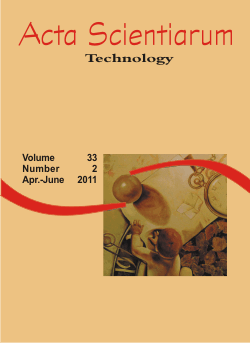<b>Serviceability of unpaved roads: a case study applied to net road from Viçosa, Minas Gerais</b> - doi: 10.4025/actascitechnol.v33i2.10328
DOI:
https://doi.org/10.4025/actascitechnol.v33i2.10328Keywords:
Roads, classification methods, objective and subjective evaluationsAbstract
This paper addresses the adaptation of the method of classification of unpaved roads developed by Eaton to the field conditions of local roads from the city of Viçosa, Minas Gerais State, Brazil, considering its potential as a support tool for the management of these roads. This study was developed encompassing objective evaluation, carried out with the application of a note scale, and subjective evaluation, according to the methodology of Eaton, which were performed by a team that accomplished the field inspections, attributing notes to the 20 sample units, each one 50 meters long and representing 10 analyzed unpaved road segments. Conclusions are as follows: (i) it was not observed any correlation between data from the objective and the subjective field evaluations, leading to the conclusion that the use of the Eaton and others methodologies can be misleading to the management of the maintenance of unpaved not reflecting their real priorities; (ii) there is correlation between the subjective evaluation of the road sections and the subjective evaluation of all sample units, indicating to be consistent the application of this procedure.Downloads
Download data is not yet available.
Downloads
Additional Files
Published
2011-02-23
How to Cite
Silva, T. O. da, Carvalho, C. A. B. de, Lima, D. C. de, & Calijuri, M. L. (2011). <b>Serviceability of unpaved roads: a case study applied to net road from Viçosa, Minas Gerais</b> - doi: 10.4025/actascitechnol.v33i2.10328. Acta Scientiarum. Technology, 33(2), 171–177. https://doi.org/10.4025/actascitechnol.v33i2.10328
Issue
Section
Civil Engineering
License
DECLARATION OF ORIGINALITY AND COPYRIGHTS
I Declare that current article is original and has not been submitted for publication, in part or in whole, to any other national or international journal.
The copyrights belong exclusively to the authors. Published content is licensed under Creative Commons Attribution 4.0 (CC BY 4.0) guidelines, which allows sharing (copy and distribution of the material in any medium or format) and adaptation (remix, transform, and build upon the material) for any purpose, even commercially, under the terms of attribution.
Read this link for further information on how to use CC BY 4.0 properly.











8.png)




